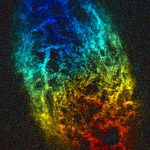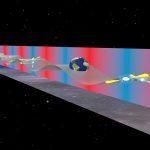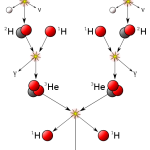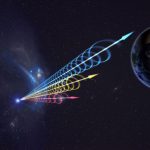Glossary of Radio Astronomy Terms
False color:
A technique scientists use to help them see the details of objects within an image. The colors the scientist picks for his or her image may have nothing to do with the color of the object or they could represent properties like its density, temperature, or composition. The viewer of a false color image must always be told what the significance of each color is.

Faraday rotation:
The interaction between a magnetic field and light, where radio waves passing through the magnetic field rotate the plane of polarization. This allows astronomers to measure the direction and strength of the magnetic field.
Fast Fourier Transform (FFT):
The mathematical operation that takes measurements made with a radio interferometer and transforms them into an image of the radio sky. The Fast Fourier Transform is a technique used by computer programs that allows the Fourier Transform to be computed very quickly.
Flare Star:
A faint red star that appears to change in brightness due to explosions on its surface. These can be rapid and sometimes periodic.

Flux:
The rate of transfer of fluid, particles, or energy across a given surface.
Free-free Emission:
The emission of radio waves from interstellar clouds as electrons momentarily bind with ionized atoms, and then move on to other atoms.
Frequency:
A measure of wave vibrations per unit time. Typically measured in hertz, or cycles per second. In radio astronomy, high frequency corresponds to shorter wavelengths, like submillimeter waves detected by ALMA. Lower frequency refer to longer waves, like centimeter waves detected by the VLA.

Frequency Modulation (FM):
An imposed signal on transmitted energy that is varied by the frequency of the wave.
Fringe:
When at least two radio waves being received by an antenna, meet and combine or meet and cease to exist.
Fusion:
A process where nuclei collide so fast they combine, and overcome the natural repulsion of positively charged protons. In the center of most stars, hydrogen fuses together to form helium. Fusion is so powerful it supports the star’s enormous mass from collapsing in on itself, and heats the star so high it glows as the bright object we see today.

Fast Radio Burst:
A Fast Radio Burst, or FRB, is a powerful, but fleetingly short-lived, burst of radio light. Recent observations of one repeating FRB — the only such FRB currently known to exist — suggest that at least some may originate in the highly magnetized regions near supermassive black holes. FRBs may be caused by various cosmic phenomena.







